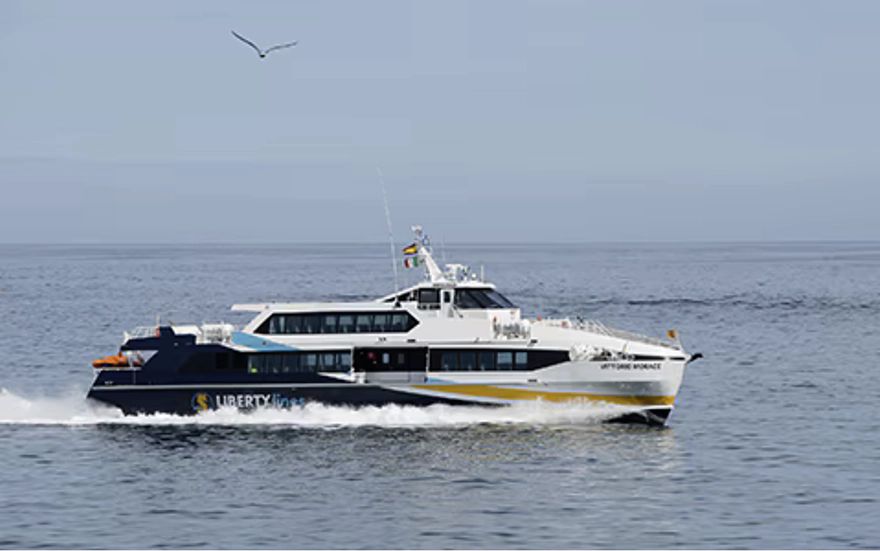
At the end of last month, the Italian shipping company
Liberty Lines officially launched the world‘s first hybrid fast ferry of its category and size in Trapani, Sicily, powered by a Rolls-Royce mtu hybrid propulsion system.
The 39.5m-long ship has a capacity of 251 passengers, reaches a speed of over 30 knots and will significantly reduce the impact of ship operations on the environment. The ‘Vittorio Morace’, built by the Spanish shipyard Astilleros Armon and designed by Incat Crowther, is the world’s first IMO HSC (High-Speed Craft) hybrid fast ferry of this size and has been classified as a ‘Green Plus’ ship by the Italian classification society RINA.
The new member of the fleet, named after the founder of the shipping company, is the first of nine ferries that will operate between Sicily and the neighbouring Aeolian and Egadi islands as well as between the Italian mainland, Croatia and Slovenia.
The battery-electric part of the drive is used for locally emission-free driving in the harbour area and as a booster. CO
2 emissions are reduced by the particularly efficient mtu Series 4000 diesel engines which can also run on the renewable diesel (HVO, hydrotreated vegetable oil). Its use can lower the CO
2 footprint by up to 90%. Furthermore, the comparatively low overall weight of both the engines and the hybrid drive system contributes to high-vessel-propulsion efficiency, thereby reducing fuel consumption and emissions.
Liberty Lines CEO Gennaro Carlo Cotella said: “We chose mtu hybrid systems because we want to minimise the environmental impact of our new fleet while not compromising on the high speed and range of our vessels. As we have trusted mtu products for decades, we have also opted for this partnership for our major fleet renewal.”
The 31 ferries in the Liberty Lines fleet operate all year round, transporting more than 3.5 million passengers on routes of up to 100Nm. They not only serve as tourist excursion ships but are above all an important lifeline for many residents of the islands who have to commute regularly. The best known are the Aeolian Islands of Panarea, Stromboli, Vulcano, Alicudi, Filicudi, Lipari and Salina, which are UNESCO World Heritage Sites.
 Pictured right: the engine room of the Vittorio Morace. The ferries will be equipped with integrated mtu hybrid propulsion systems from Rolls-Royce, each comprising two mtu 16-cylinder Series 4000M65L engines, two electric engines, two variable-speed gensets, three battery systems, the switchgear and power supply system and the mtu NautIQ Blue Vision NG control and monitoring system. The vessels will utilise different operating modes as required
Pictured right: the engine room of the Vittorio Morace. The ferries will be equipped with integrated mtu hybrid propulsion systems from Rolls-Royce, each comprising two mtu 16-cylinder Series 4000M65L engines, two electric engines, two variable-speed gensets, three battery systems, the switchgear and power supply system and the mtu NautIQ Blue Vision NG control and monitoring system. The vessels will utilise different operating modes as requiredDenise Kurtulus, vice president Global Marine at Rolls-Royce Power Systems, said: “Liberty Lines is the ideal partner to demonstrate the progress that can be made towards environmentally and climate-friendly ship operation. We have used all possibilities and combined highly efficient combustion engines with exhaust gas aftertreatment, batteries and electric motors with an intelligent electronic control system to create an emission-optimised system.
“Together with Liberty Lines, Armon and Incat Crowther, we have developed a passenger ferry that will set new standards in this category of shipbuilding. Our goal is to help this technology achieve a breakthrough.”
The Marine business is one of the five key strategic initiatives presented by the Power Systems division at the Rolls-Royce Capital Markets Day in November 2023. All components are coordinated by the mtu NautIQ Blue Vision NG control and monitoring system. The complete propulsion systems of the first two ships will be monitored by the mtu NautIQ Foresight equipment health monitoring system. It collects data on the technical condition and analyses and stores it in order to improve the operational availability of the ship, reduce maintenance costs and lower fuel consumption and thus CO
2 emissions.
When entering and leaving the port areas, the batteries ensure silent and emission-free manoeuvring. They supply power to all the ship’s electrical equipment and the bow thrusters. When the ship leaves the harbour and increases speed, the mtu combustion engines are used. They drive the propellers directly, enabling the ship to travel at speeds of up to 30 knots.
At the same time, they drive the hybrid electric motors via the gearboxes to charge the batteries and supply the electrical consumers on board without having to operate gensets. The generators on board are available as a back-up. When the ship is in harbour, the batteries are used for the entire electrical supply on board during shorter stopovers, also silently and emission-free without power generators. During longer stopovers, shore power can be connected to recharge the batteries.